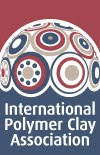There's always much discussion online and at retreats and classes about the best way to finish your work. I love a matte finish on some things but there are some techniques that demand a shine. How best to achieve it? At the risk of being called nasty names, I have to say that I've never been a fan of acrylic finishes. Yes, I know some surface elements may need to be protected with some sort of finish and I'm not opposed to that. But, I've only seen a handful of pieces coated with acrylic finishes like Future or Varathane that didn't look as if they were coated with Future or Varathane. I've tried it myself and found it close to impossible to get a flawless finish with these methods.
For those who have asked, here's my method for a shiny finish with lots of depth. First of all, if you put something in the oven that isn't perfect or close to perfect, that's exactly how it's going to come out of the oven. There is no oven genie. Don't be in a hurry to bake anything. That's one of the biggest mistakes I made when I first started working with clay and I've had lots of students who say the same thing. Take your time to make it right before you bake. I can promise you that spending hours trying to sand a lumpy pendant or bead is no fun and it will NEVER look right no matter how much sanding you do.
I sand with 400, 600, and sometimes 800 grit sandpaper. Before I move past the 400 grit, I run my fingers over the entire surface of the piece. If I feel any sort of scratch or roughness, it's not time to move on to the 600 grit. When the piece feels like silk, I go to 600 and then 800 grit. It usually takes me no more than 5 or 10 minutes to sand a piece through all three grits.
After rinsing and drying the sanded clay, it's time to buff. I use a small Foredom buffer designed for jewelers with a variable speed. Again, no more than 5 to 10 minutes to buff a piece and I'm done. That's it. No drips, no mess, no bubbling, no drying time involved, no re-baking and no worrying about the finish peeling or chipping. Plus, the depth that you get from buffing is pretty amazing! If only I were a better photographer . . .








4 comments:
Bravo! I totally agree about your comments concerning Future Floor varnish and deck sealing products...they belong on one's floors not on their wonderful polymer clay pieces.
Haha! It seems great minds think alike perhaps. Thanks for posting Lindly.
I love to hear (read) pro-sanding and buffing talk! Preach on sister buffs-a-lot. :)
Thanks Christie!
Post a Comment